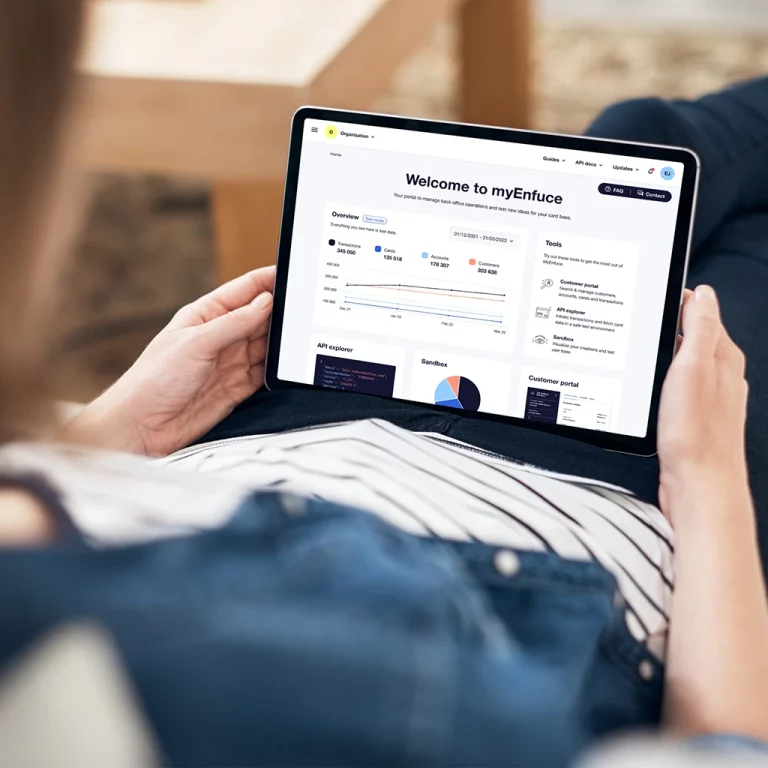Monitor your card programme with rich data
Unlimited data insights for unlimited opportunities - sounds good doesn’t it?
Contact usData on your card programme empowers you to make data-driven decisions – so important, right? With Enfuce Data Insights you can optimise operations, upsell relevant features, enhance customer experiences, and drive innovation. Ultimately data is knowledge, and knowledge is power, and when this flows to your fingertips it’s your competitive advantage to seize.
Having real-time data on payments also increases the sense of security for your cardholders, because it allows them to monitor their card for any instances of fraud. That’s why it’s vital that your issuer processor partner shares detailed data with you, so you can relax knowing that you and your customer’s are in safe hands.
Types of data insights at your fingertips
An analytics dashboard on your card base
Our customer portal comes with data on big-picture items, like the size of your current card base, transaction volume, and more. This allows you to gain quick insights into how things are going in your card programme.
Detailed daily data export files
You will get a daily export of all your card programme data for a detailed analysis. Every single transaction at your fingertips, down to the smallest detail like where a certain purchase happened, what was purchased and so on. The files also include data about card production, for example, how much un-invoiced/invoiced balance you have and what the interest accruing balance is. This data will help you analyse customer behaviour and trends and fill in necessary compliance requirements for reporting.
Real-time access to data through APIs and webhooks
Get detailed information about transactions, as they are happening. Enfuce enables notifications like alerting the cardholder when a transaction has taken place so they feel safe knowing their card isn’t being used behind their back.

What your data insights can achieve for your customers
Give insights to your cardholders on their spending
Offer value to your customers by showing them trends in their spending patterns. Help them understand their consumption or take control of their finances with detailed reports on their purchases.
Add safety and control to corporate payment cards
Allow administrators real-time access to see who uses their payment cards and how. Prevent user fraud and provide insights into how a company should optimise their card base and budgeting for projects.
Empower your cardholders to choose exchange rates
Enfuce gives real-time information on how much the exchange rate is for this specific card and benchmarks it to the reference exchange rate. This gives your customer the option to see which of their cards is the most affordable to complete purchases in other currencies.
What your payment analytics can achieve for your business growth
FAQ
What are the benefits of collecting and analysing payment card data?
- Enable informed decision-making based on data rather than guesswork.
- Identify opportunities for growth and improvement, as well as potential risks.
- Improve efficiency and performance by identifying inefficiencies and bottlenecks
- Enhance customer understanding and enable personalised experiences.
- Drive innovation and product development by identifying market gaps.
- Measure performance and ROI, allowing for adjustments and resource optimisation.
How are you ensuring that all payment card data is safe from hackers?
Enfuce takes security and fraud extremely seriously. We are fully compliant with relevant GDPR, PCI-DSS and PSD2 certifications. Our platform is monitored 24/7 and patched rigorously to prevent any harm from coming to our customers. We are proud to have been named a fraud prevention leader by the prestigious Celent.
How can I effectively use payment analytics to identify patterns and trends in customer payment behaviour?
- Define your objectives: Clearly define the specific patterns and trends you want to identify. For example, you might want to analyse late payment trends, payment method preferences, or seasonality effects on payment behaviour.
- Define key metrics: Identify the key metrics that will help you measure and analyse payment behavior. Examples include average payment time, payment frequency, payment amount distribution, and customer segmentation based on payment patterns.
- Visualise the data: Use data visualisation techniques such as charts, graphs, and dashboards to gain insights from the data.
- Perform statistical analysis: Apply statistical techniques to uncover patterns and trends in the data.
- Segment your customers: Divide your customers into meaningful segments based on their payment behaviour.
- Use predictive modelling: Utilise predictive analytics techniques to forecast future payment behaviour.
- Monitor and track performance: Continuously monitor and track the identified patterns and trends over time.
- Take action: Translate the insights gained from payment analytics into actionable strategies.






